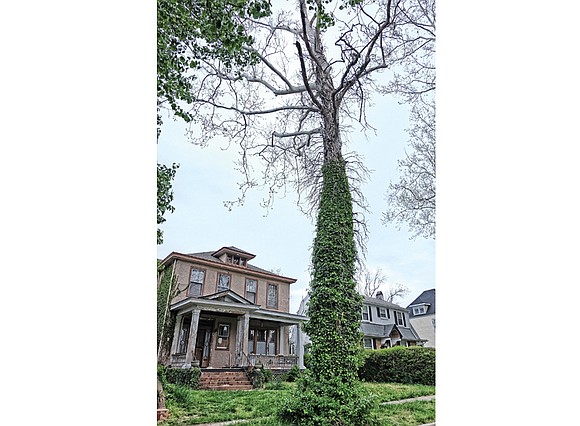Tree problems go unanswered by city
4/29/2018, 1:08 p.m.

Editor’s note: Just before the Free Press Wednesday deadline, Spencer Turner sent a text message to a Free Press reporter stating: “Thanks for help. They are cutting tree down Friday. The power of a free press.” As of deadline, the Free Press had not been able to confirm Mr. Turner’s statement with city officials.
By Jeremy M. Lazarus
Spencer Turner shudders every time he looks at the big sycamore tree that the city planted decades ago on its right-of-way in front of his home in the 100 block of West Lancaster Road in North Side.
Mr. Turner knows the tree is dying. Some of its big limbs already have toppled into his yard, and he can see large, decaying upper branches ready to fall.
“One day, a big storm will come along, rip this tree right out of the ground and land it on my house,” said Mr. Turner, a Lyft driver who has lived at the home for eight years.
In a bid to forestall damage, Mr. Turner said he repeatedly has called the Urban Forestry Division of the city Department of Public Works during the past two years. He also asked his City Council representative, Ellen F. Robertson, 6th District, to intervene. So far, nothing has happened, Mr. Turner said.
The Free Press sent a query Monday to Bobby Vincent, the city director of Public Works who oversees the Urban Forestry Division, and to Ms. Robertson, but did not receive a response.
In the wake of the Free Press query Mr. Turner said that he did get a call from Ms. Robertson’s legislative aide, Kiya Stokes, who promised to look into the situation.
Mr. Turner is increasingly frustrated after watching a city-hired tree company trim neighbors’ trees but do nothing to the dying sycamore. He’s also annoyed after seeing two large, healthy trees removed from the front of a home that was renovated a few doors west, with replacement saplings being planted in their place.
The city each year lists the trees it plans to cut down by address. Eighty-six were on the list posted in December, but Mr. Turner’s tree was not on it.
“They keep bypassing me and I can’t find out why,” he said.
The city does not post information on the total number of trees that need to be removed.
However, the relatively small number of trees that are to be taken down in front of homes appears to mirror the sharp decline in the city’s new tree plantings. Instead of planting more than 2,000 new trees each year, the norm between 2009 and 2015, the city in 2016 and 2017 planted an average of 200 saplings.
An interactive map the Urban Forestry Division posted online is supposed to allow residents to find information on the condition of city-owned trees in front of their homes, according to the website. The information is based on a survey of each street’s trees that the city undertook from 2013 to 2015.
However, the map only identifies tree locations and contains no information about their condition, the Free Press found in trying the map.
The division has a form that allows homeowners to apply to take down a city tree at their own expense. But Mr. Turner said he can’t afford to remove the tree himself and feels it’s the city’s responsibility.
Mr. Turner is not alone in worrying about tree damage.
Marie M. Hart attended the Richmond City Council meeting Monday night to renew her concerns during the public comment period about two city trees that she said are damaging the sewer line leading to her home in the 3000 block of Kelrae Drive in South Side.
She has complained about the trees for several years, but has yet to get any city support for removing them. Her City Council representative, Reva M. Trammell, 8th District, has reported the problem, but acknowledged there has been no change.
Ms. Hart said she had a plumber check the sewer line, and he reported that the tree roots are the problem, she told the council on Monday night.
Recently, waste in the sewer line backed up into her home because of blockages created by the tree roots, she said.
She said people in the Urban Forestry Division dismissed the explanation when she sought help, but she said the plumber who reopened the line reconfirmed that roots from the trees are the problem.






